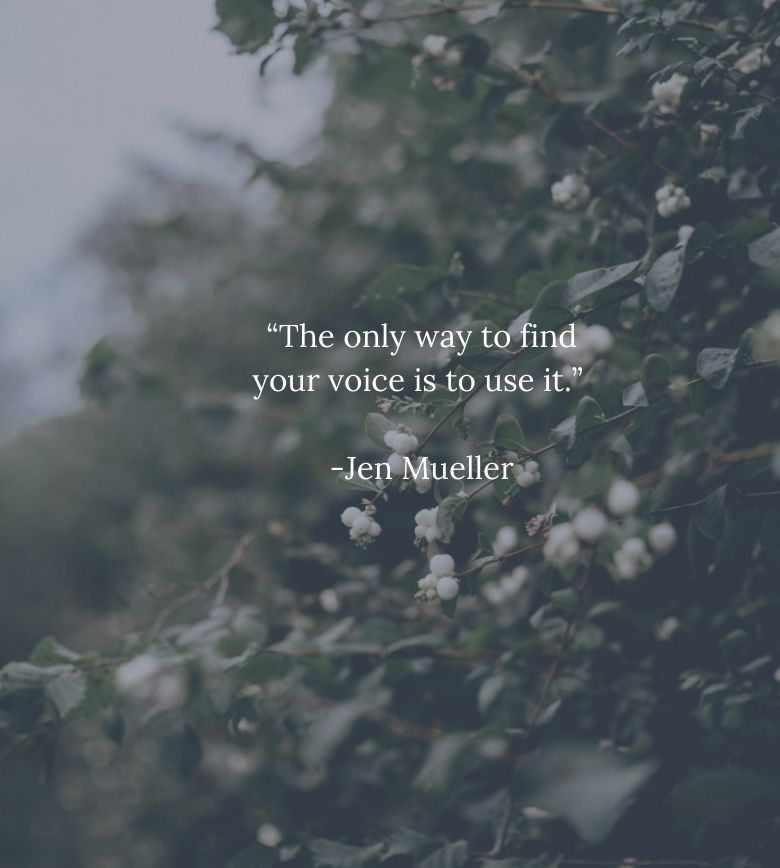Learn to sell with story & make a living creating.
A blog for fine artists & photographers.
SHARE
She asked me, “what exactly is the difference between brand voice and brand personality? I feel like there’s so many ‘Brand * fill in the blank*’ terms out there.” Keeping track of ALLLL the brand-isms is certainly no easy task. Especially because every marketer can have a slightly different take on the topics.
Simply put, your brand voice is an extension of your brand personality and is defined by your unique tone, rhythm, and language.
Whether you fill canvases with color or capture special moments behind a lens- as an artist you’re most likely a visual learner. In this post I’ll walk you through five visually based strategies to help you better understand your brand voice and how to find it.
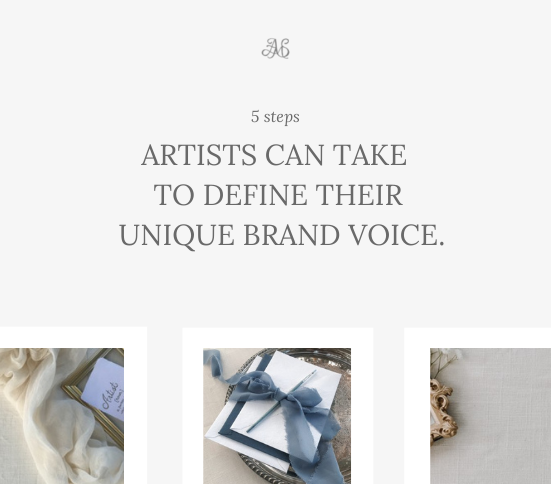
Here’s an easy analogy to help you make sense of it all (as a nature-y person I’m going to put it in nature-y terms if that’s a-okay with you!)
Think of your brand messaging as a tree.
The roots of your tree are your brands guiding principles:
- Your WHY
- Your core values
These influence every aspect of your messaging
The tree trunk is your brand personality…the essence of your brand as if it were a living breathing person.
Your tree has three main branches that make up you brand voice:
- Tone: The attitude and inflection of voice
- Vocab: The language used with voice
- Cadence: The rhythmic tempo of voice
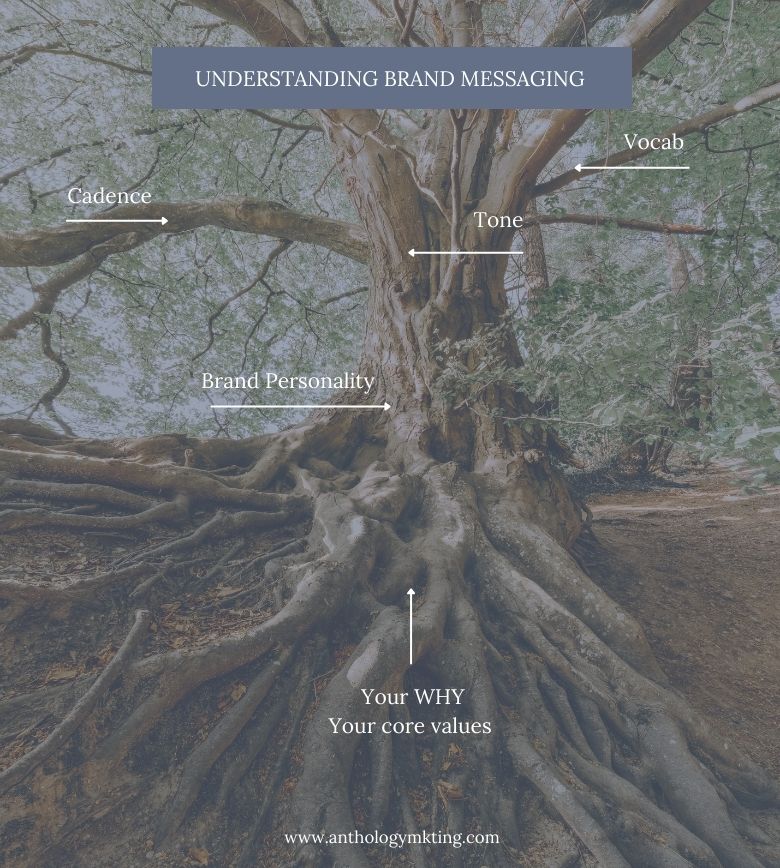
Now we could go on and on about all the additional pieces of your messaging that branch off from your voice but for simplicity sake let’s keep it there for now!
Oh, and all the people who are drawn to your tree, the ones who can’t help but picnic and meditate or make art underneath your leaves…that’s your ideal audience 🙂
*PRO TIP*
For this post, you’ll want to open a notebook! Once you have sketched out your brand voice you’ll also want to transfer the details into something like a Google or Word doc so you can refer to it for all of your future copywriting needs.
Your favorite brands all have what are called Brand Guidelines: essentially a company document that lists out all of these details to keep everyone consistent! This wonderful Medium article has a list of some popular brands and how they define their brand voice. Just to get the ideas flowing for you!
Alright, pencils ready!
Step one: Conduct a 5 senses exercise
So here’s my secret…When it comes to defining a brand voice for artists and creatives I don’t think it’s best to start with the words first. No, I think starting with the visuals is the key!
You’re probably someone who has always been very aware of your surroundings. Attuned to the sights, sounds, smells, and feelings around you.
In my Brand Consulting sessions I walk my clients through this 5 senses exercise. The 5 senses exercise is a way to connect with your brand in a non-traditional, less formal way. For this exercise you’re going to imagine your brand, not as a symbol of your business, but as a physical place that you could visit and experience!
Take some time with this exercise to really visualize your answer to each question. Have some fun with it! (I recommend doing this by hand and sitting somewhere that makes you feel peaceful!)
Answer the following questions:
- Start off by picturing a door, behind that door is a beautiful room that represents your brand.
- Once you open the door and step into the entryway you take notice of the space. What do the walls look like? Are they painted or plastered, made of stone, or wooden beams?
- Notice the lighting in the room: is it lit by a roaring fireplace or candlelight? How about sunlight or moonlight beaming in through large windows?
- As your eyes sweep the room, what sort of furniture do you see? Maybe there’s couches for lounging, a kitchen or table for entertaining, bookshelves, or an easel or painting in the corner?
- You realize that there has been music playing this whole time! What does the music sound like in this room? Is it low and soft, catchy, upbeat? Is it all acoustics or are there lyrics?
- And by gosh what’s that scent filling the room? Is it a candle burning? What does it smell like? Maybe it smells like fresh flowers, something baking, fresh paint, brewing coffee?
- As you make your way across the room you notice a desk along the wall with a plate of food on top. What kind of food is it? How would you describe the flavor?
- What else do you see spread out on the desk? Handmade paper, a stack of notebooks, color coded supplies, crystals, potted plants?
- As you nibble on a bit of the food you wander to a door next to the desk-when you step through the door what do you find on the other side? A garden patio, a balcony over the city, a private library or studio, a beachfront view?
- What do you hear as you take in this new scene in front of you?
- How does visiting this beautiful place make you feel?
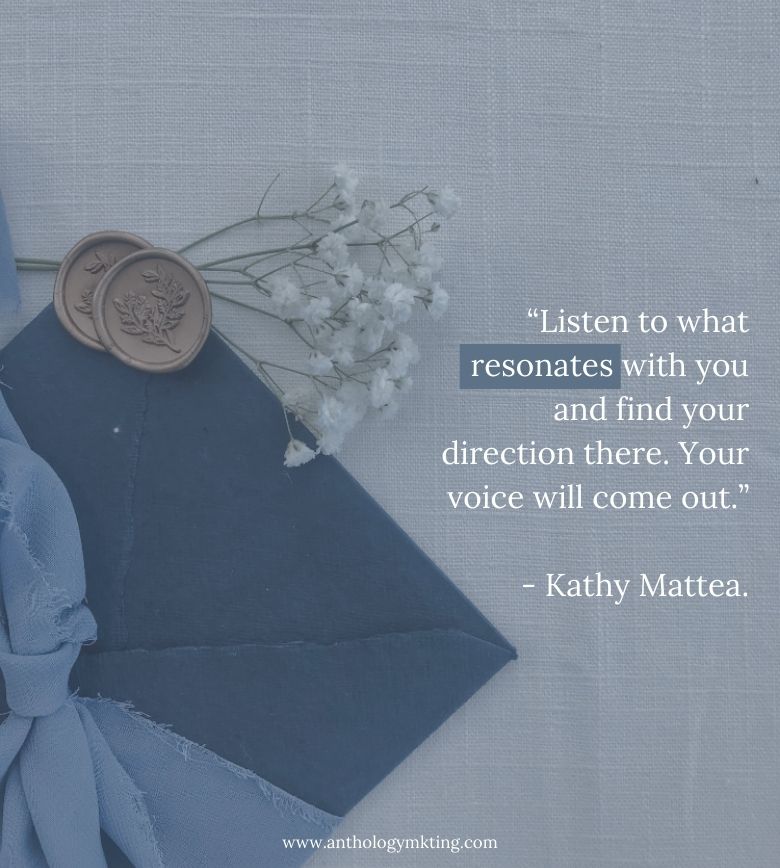
Step two: Create a Pinterest brand board
Now that you have a picture in mind of what your brand would look like as a place to visit, let’s hop on over to Pinterest (because I know you love it just as much as I do).
If you don’t have one already, go ahead and create a board that can be called “Business name aesthetic.”
Next, go through and pin a few images that you feel represent your brand visually. Consider all of the elements you just described in your previous exercise.
Pssst… don’t worry tooooo much about the language yet but take note of the keywords you typed into the search bar to find the images that resonate with your vision. Just jot them down for now.
When I work with a client on their website copywriting We always start with a shared Pinterest board for their brand. Brand designers do this all the time by creating mood boards.
Personally I’ve found it helpful for both my client and I! They are better able to communicate their brand in visuals and as a visual and linguistic person myself, seeing their ideas better helps me put words to it!
Here is a example of what I have included in my AMS brand board aesthetic:
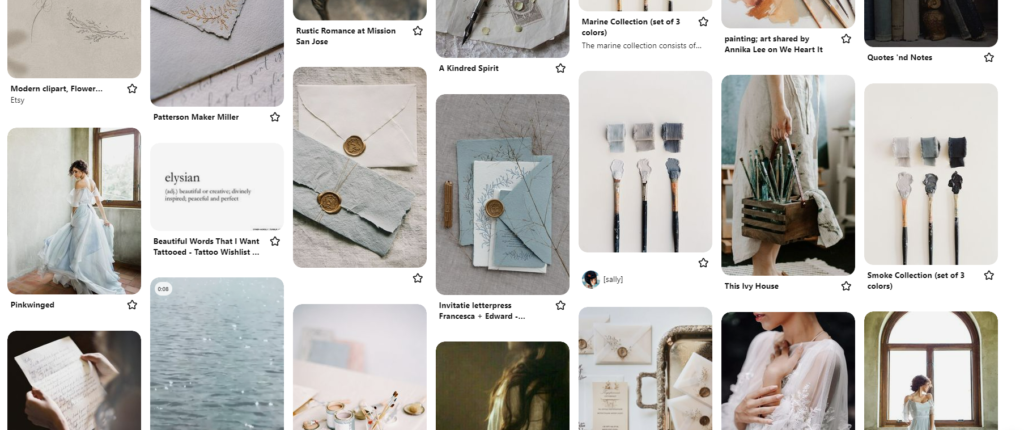
Step three: Write down brand voice adjectives
So now that we’ve zeroed in on the visuals we love so much, let’s start with a little word witch magic shall we?
Turn to a blank page in your notebook and start brain dump for ten minutes. List ALL of the adjectives you associate with the images.
Look at the language you used in your 5 senses exercise. What adjectives do you have? What are some synonyms of those words?
Look at the images you pinned. What adjectives are used in the descriptions of each pin? (pull out that list you made in the last step of the words you typed in the search bar to find these images).
Can you think of a magazine that reflects your Pinterest brand board? Maybe it’s KinFolk, Country Living, The Knot etc.
Thumb through the pages and look for keywords in the articles. Look up the magazine’s website and read through their about page-how do they describe their vibe?
*PRO TIP* Thesaurus is your BEST FRIEND HERE.
Step four: Find character comparisons
Okay, so here is where my book nerd-ish-ness comes out! After coming up with your visuals and putting words to them…can you think back on your favorite books, movies, musicals etc. that have characters that fit these descriptions?
For example: for my brand I like to compare AMS to Belle and Legolas (interesting combo I know, but hear me out).
- Belle: sophisticated, eloquent, and a lover of stories and adventure
- Legolas: Determined, quick witted, observant, and in tune with nature

Not only do character comparison help us better visualize brand voice because we know how they speak they also help us understand emotional attachment to brand voice.
Do we not feel emotionally tied to the characters we read and watch?
Their voice is distinct from others around them. It is important for our ideal audience to feel an emotional attachment to our brand the same way they do with a character.
A 2021 study shows that 64% of consumers have felt an emotional connection to a brand they are loyal to.
The best way to elicit an emotional response from your audience is to give them a voice they can recognize, one they can relate to and take comfort in.
Step five: List brand voice do’s and don’ts
So now we have a pretty thorough list of descriptions for your brand voice. We have characters who emulate this voice that you can look to for reference and inspiration.
Now we have defined a lot of what your brand WOULD do with voice, let’s look at what your brand voice WOULDN’T sound like.
Consistency of brand voice actually can increase revenues by 33%
Imagine you had to tell someone else to write for your brand what would you tell them to do when writing in your brand voice?
Would you tell them to use:
- Lots of exclamation points?
- All caps when things get exciting?
- Long descriptive words?
- Short, sweet and to the point words?
- Girly feminine language and references?
- Nature inspired analogies?
- Make puns in writing, or keep it professional?
What would you tell them to avoid when writing in your brand voice?
- “Girl boss” language?
- Excessive exclamations?
- Fluffy imagery?
- Long paragraphs?
- Choppy sentence structure?
- All caps?
- Pop culture references?
Figuring out what your brand wouldn’t say in your defined voice can help you stay consistent whether it’s writing website copy, emails, captions, or even recording videos that need a script.
Use the do’s and don’ts as a checklist when editing anything written in your brand voice: Does it include AB & C elements? Does it exclude XY & Z?
You’ve started to define your brand voice, now what?
Now that you have a good grasp on your brand’s voice, where should you be using it?
Quick answer: everywhere your brand exists
Long answer: Your brand voice should be present in your social media content, your Instagram Stories, Reels, captions, your emails to your list (if not now then in the future when you have that going!), In your client or customer communication documents, service or product guides, and especially on your website in your copywriting!
Not feeling super comfortable with infusing this voice into your website words? Let’s chat about your website together! Book a free discovery call here!
Feel free to sit on these exercise answers for a few days or a week then come back to it.
Can you add anything to your:
- 5 senses exercise
- Pinterest board
- Adjectives list
- Character comparison
- Do’s and don’ts list
In closing, remember that developing brand voice takes practice. Whenever you write something for your business ask yourself, does this line up with what this character would say? Does this language fit the space I envision for my brand?
